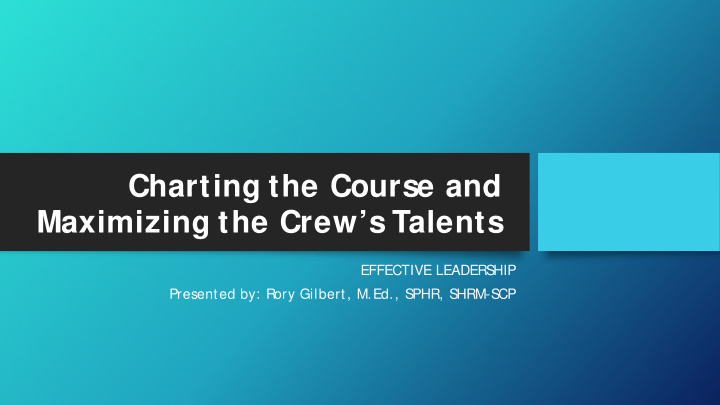



Charting the Course and Maximizing the Crew’s Talents EFFECTIVE LEADERS HIP Presented by: Rory Gilbert, M.Ed., S PHR, S HRM-S CP
Expectations? 2 1/ 22/ 2016
Principles 1. Y ou cannot lead if no one follows. 2. S elf-awareness is a critical component of effective leadership. 3. Leaders are most effective when they recognize and value that not everyone thinks like they do. 4. Today’s session provides a chance to learn more about yourself, the people you work with and how to bridge the divides that impede optimal results. https:/ / www.ted.com/ talks/ derek_sivers_how_to_start_a_moveme nt? language=en
S ession Obj ectives 4 • Learn the DiS C framework • Learn the strengths and challenges of your own style • Learn how your style interacts with other styles • Identify strategies to improve communications with one or more employees 1/ 22/ 2016
Directions • Select five cards. • Place the card that is least like you face down on the table. • Mingle with the group and trade cards to get an increasingly accurate description of yourself as reflected in your cards. • When you have four cards that describe you well, think about your workplace strengths and select the two cards in your hand that best reflect those strengths . • Discard the other two by placing them on a table face up. • Trade any card in your hand for any card on any table that you believe more accurately describes your workplace strengths.
DiS C Dimensions 6 Fast Paced Dominance Influence What? Who? & Questioning Task focused People focused & Affirming Conscientiousness Steadiness Why? How? Moderate Paced
4 Corners Activity • What strengths does this group bring to the workplace? • What do we need and want from others to be successful in the workplace? • How are we often misunderstood? • As a group, what would our slogan be?
Reading Others (optional)
Application • Identify someone you work with routinely with whom you have communication challenges. • Using the learning aid you received, consider what style they might have. • How might your style and theirs conflict? • S hare your situation with a partner and discuss possible strategies to improve communication.
Application – Group Discussion • What strategies might help?
Conclusion • Questions • Commitments – what will you do? • More information about DiS C and other resources
Recommend
More recommend